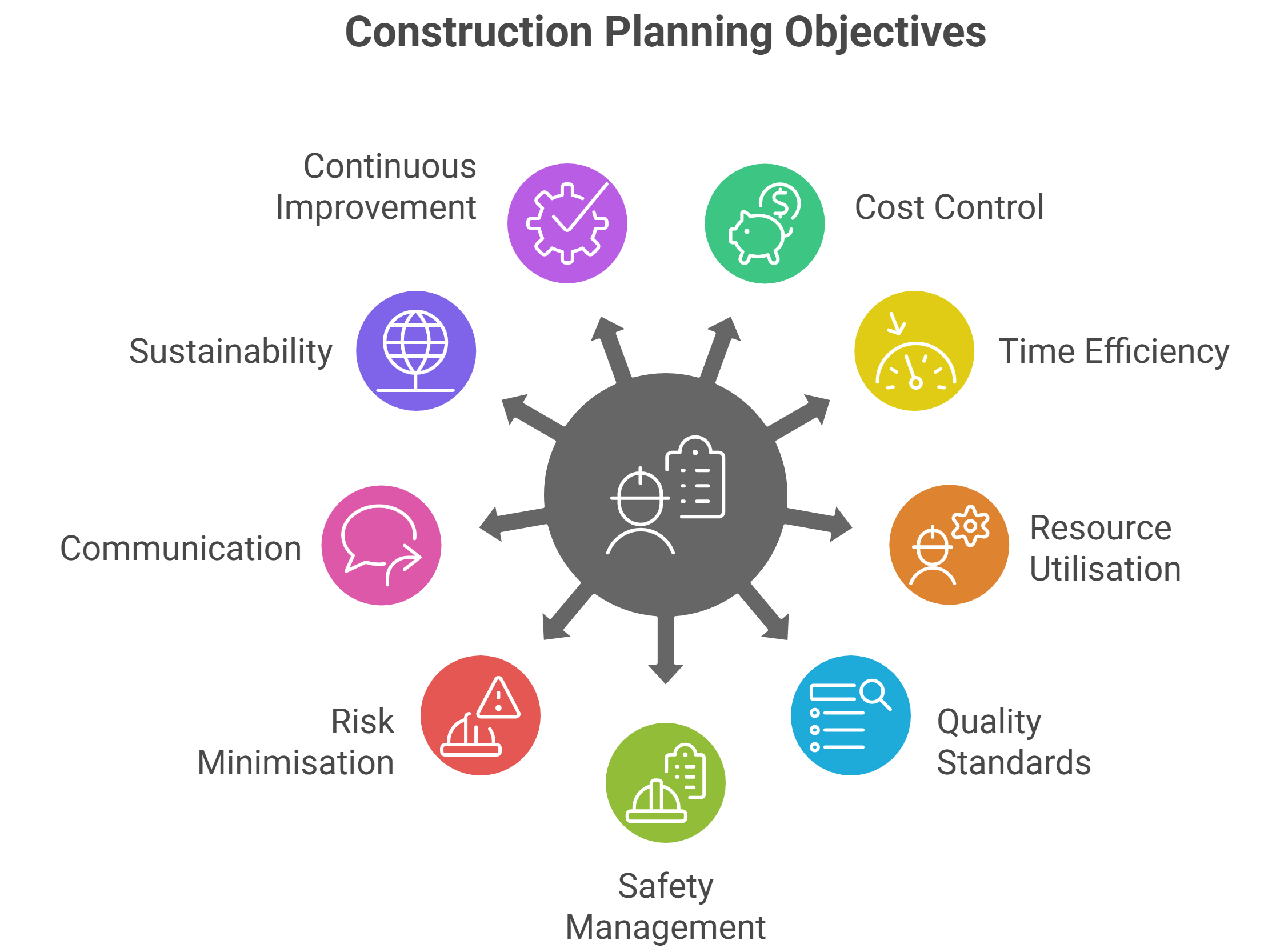Effective scheduling, resource allocation, and cost efficiency are the core objectives of construction planning, ensuring projects meet deadlines and budgets. These objectives of construction planning also improve safety outcomes, strengthen coordination between teams, and enhance stakeholder satisfaction by creating clarity and control across all project stages.

Ensuring Cost Control
Financial forecasting kicks off strong cost control in construction project management, breaking down expenses and timing procurement to avoid surprises. Detailed estimates and phased budgeting help predict cash flow, reducing the chance of overruns that plague many builds. Tools like CostX or Cubit enable real-time tracking, ensuring every dollar counts toward profitability.Objectives of Construction Project Planning
Regular audits keep spending in check, allowing teams to spot variances early and adjust without derailing the project. In construction project management, this approach not only safeguards margins but boosts long-term viability. Here are key practices:
- Early budgeting and estimation
- Value engineering
- Regular cost audits
- Variance analysis
Improving Time Efficiency
Well-structured scheduling boosts on-site productivity in construction project management through tools like Gantt charts and critical path methods. Milestone tracking prevents idle time and maintains momentum. McKinsey reports only 25% of projects meet deadlines without robust planning, proving objectives of construction planning enhance efficiency.
Maximising Resource Utilisation
Optimal resource use in construction project management hinges on smart allocation of materials, equipment, and labour to boost productivity without waste. Inventory management and scheduling prevent shortages, while tracking KPIs like equipment downtime or labour efficiency ensures smooth operations. Essential practices include:
- Labour productivity assessments
- Equipment allocation planning
- Inventory management systems
Enhancing Quality Standards
Maintaining top-notch quality starts with embedding assurance frameworks right from the planning stage in construction project management. Inspection schedules and ISO 9001 compliance help catch issues early, avoiding costly fixes. In Australia, quality deviations contribute to up to 15% of rework costs on projects; this highlights why objectives of construction planning prioritise consistency for durable results.
Strengthening Safety Management
Integrating safety early in construction project management cuts accidents by addressing hazards through assessments and PPE compliance routines. Site audits foster a culture of vigilance, lowering insurance claims. Safe Work Australia data shows prioritised safety planning can reduce site injuries by around 28%; this proactive step protects workers and maintains project flow.
Minimising Project Risks
Early risk identification in construction project management tackles financial, environmental, and operational threats to prevent costly setbacks. By mapping potential issues, teams can implement buffers that keep things on track.
| Type of Risk | Mitigation Strategy | Potential Impact |
|---|---|---|
| Financial | Budget contingency planning | Reduced cost overrun |
| Schedule | Critical path adjustment | On-time delivery |
| Safety | Regular site inspections | Fewer incidents |
Proactive risk management forms the backbone of objectives in construction planning, turning uncertainties into manageable elements for smoother execution.
Promoting Communication and Coordination
Collaborative tools streamline information flow in construction project management, aligning stakeholders through BIM and cloud dashboards for better synergy. Daily briefings cut misunderstandings, fostering inter-team coordination that drives progress. This transparency ensures everyone stays on the same page, reducing errors and enhancing overall outcomes.
Supporting Environmental Sustainability
Modern planning weaves in eco-goals to trim waste and boost energy efficiency in construction project management. Choosing green materials and monitoring carbon footprints make a real difference. CSIRO research indicates sustainable practices can reduce site waste by up to 10%; this commitment not only meets regulations but future-proofs builds against environmental shifts.Construction Planning: Everything You Need to Know When Assessing Construction Planning Skills
Driving Continuous Improvement
Data-driven reviews refine processes in construction project management, capturing lessons from post-project debriefs and benchmarking against standards. Feedback loops build a database of insights for sharper future strategies. Improvement practices involve:
- Regular team debriefs
- Digital documentation
- KPI monitoring
Building Better Outcomes through Strategic Planning Objectives
Tying cost, time, quality, safety, and sustainability together creates a unified approach in construction project management that elevates every phase. This strategic focus shapes the building construction process from start to finish with precision. Ultimately, it delivers smarter, safer, and more resilient projects that stand the test of time.


